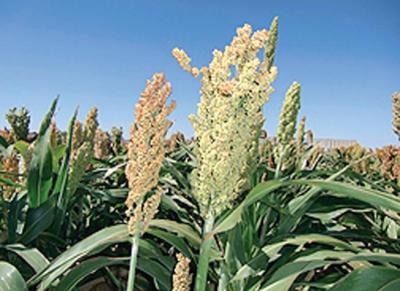
Sorghum is the perfect crop for eastern Colorado, according to researchers who recently finished field experiments at the Central Great Plains Research Station in Akron.
In 2014 Colorado State University conducted performance trials on the plains of hybrid sorghum varieties submitted by seven different seed companies. On Tuesday Jerry Johnson and Sally Sauer, two of the researchers who conducted the project, hosted a “sorghum field day” in Akron in order to show farmers their results.
One of the things they found was that sorghum is cheaper to grow and produces higher yields in the Colorado plains than corn.
Johnson started his presentation by listing a few advantages to growing grain sorghum rather than corn.
“It’s very drought stress tolerant,” he said. “There’s no disease or insect problems, and that’s a big deal… it’s a non-GMO product, so it looks good in the public eye.”
Sorghum is grown for both grain and fodder and is used in foods such as molasses. It’s native to Africa, which is why it grows so well in hot, dry climates.
The field trial in Akron was one of three that Johnson and five other researchers conducted in 2014. The others tested hybrid seeds at CSU research stations in Brandon and Walsh.
Out of the hybrid seeds researchers tested at Akron, the highest-yielding was a variety called 722B made by Dyna-Gro Seed, a company based in Loveland. It yielded 103.8 bushels per acre. Mild temperatures and rainfall at crucial times during the growing season contributed to the high yields, and most of the other seed varieties produced well, too.
Johnson handed out a list of seed varieties and their results to all the farmers who attended the field day.
“When you’re choosing a hybrid, just pick the traits you want and find a seed on this list that matches that,” he said. “And if you’re buying seed from someone who’s not on this list, talk to them and encourage them to contribute seeds for testing.”
Sauer gave farmers some advice on how to plant sorghum. For example, it’s best to plant when the soil temperature is between 50 and 55 degrees.
“Here in Colorado, that means you’ll usually be planting around mid-May,” Sauer said.
Akron’s sorghum field day also included a presentation by Ph.D. candidate Sarah Miller on the effects of soil on sorghum roots, and a chance for farmers to walk through the field trials and see the results for themselves. Similar field days were offered at the Brandon and Walsh research stations on Sept. 30.
Stephanie Alderton: 970-867-5651 ext 227, salderton@fmtimes.com or twitter.com/slalderton

